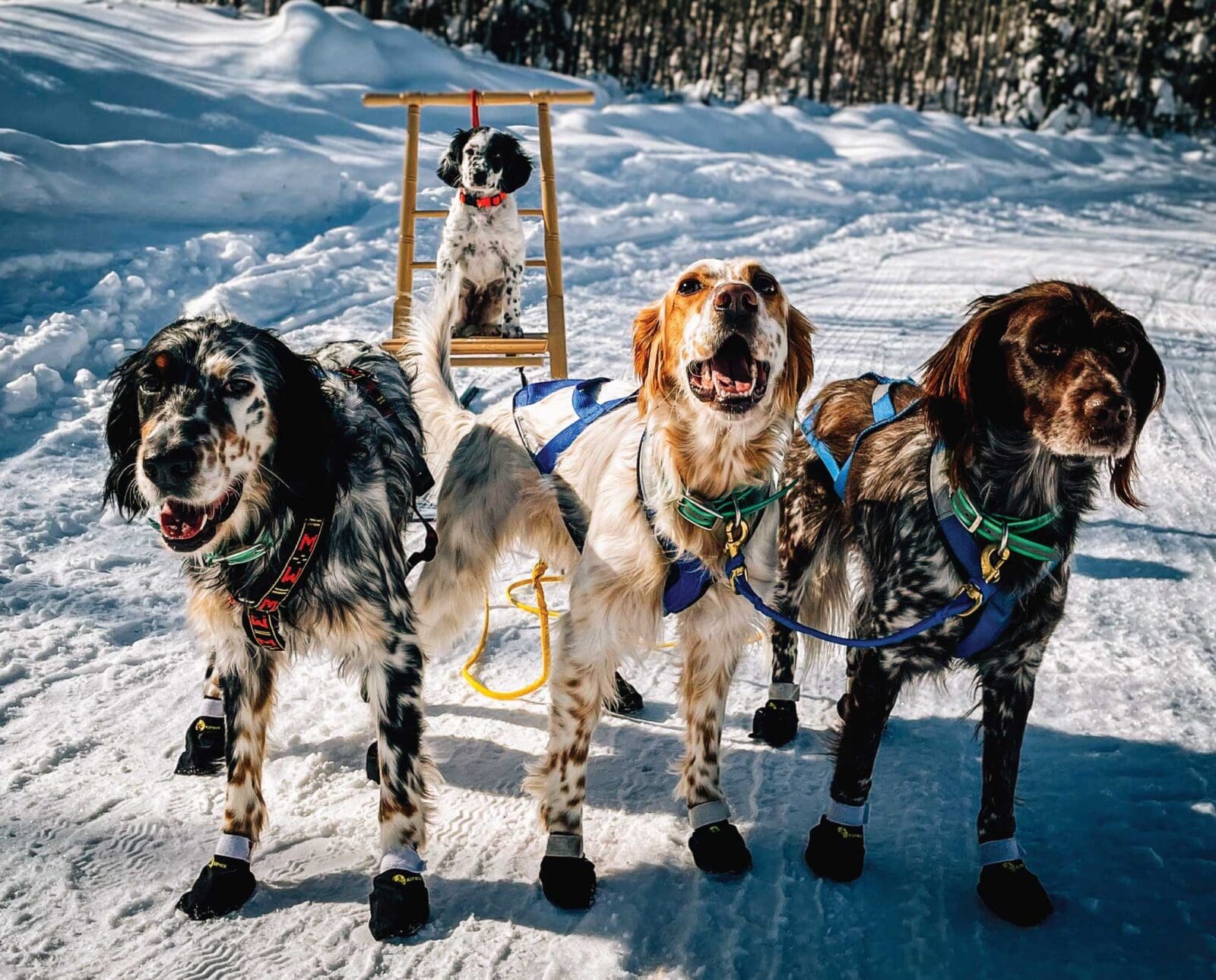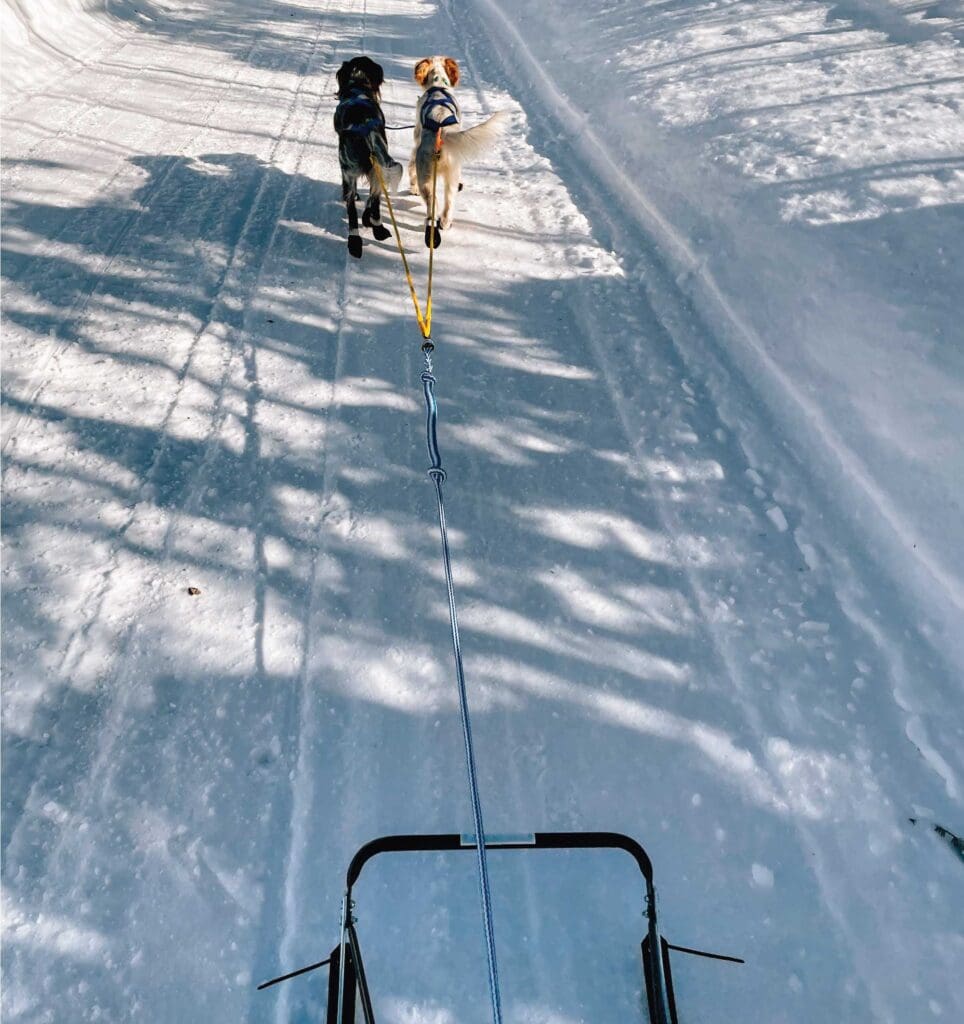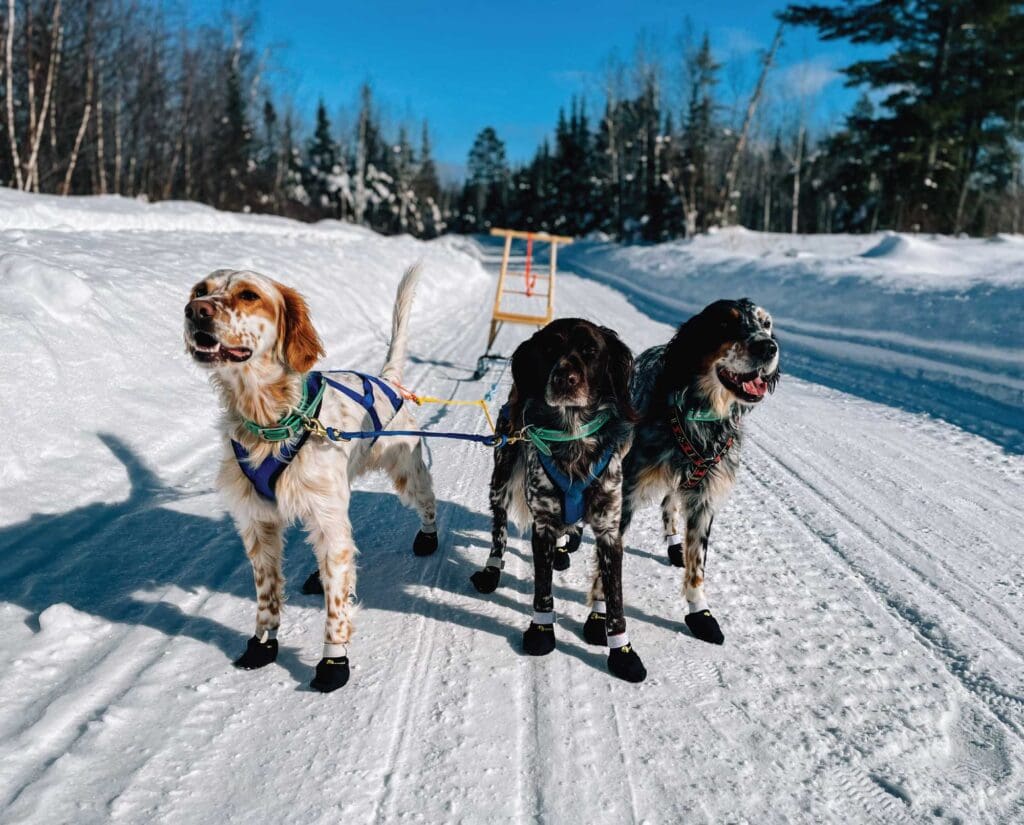Home » Hunting Dogs » Using Bird Dogs for Kicksledding
Using Bird Dogs for Kicksledding

Bailey Petersen lives in Two Harbors, Minnesota and is the…
Pursue a new hobby in the off-season by participating in winter dog sports with your bird dogs
Living in the center of a continuous forest, my nomadic bird dogs don’t spend much time walking on a leash around our home. As a result, they have terrible leash manners. Luckily for me, their tendency to pull works wonderfully with pulling sports like skijoring and kicksledding, as long as you can get them to stop. This is where “whoa” comes into play. This one word allowed me to dive into winter dog sports with my bird dogs.
Listen to more articles on Apple | Google | Spotify | Audible
“Whoa” is a critical command nearly every pointing dog and sled dog owner uses. In both worlds, it simply means “halt.” This term encourages or demands steadiness on birds in the upland scene. However, regarding sled dogs, this command is paired with heavy pressure on the foot brake while setting the snow hook.
The patchwork of logging roads, snowmobile trails, and minimum maintenance roads that weave around my home have several feet of snow on the ground for five or six months out of the year. This gives me plenty of opportunities to get creative about exercising the dogs in the off season, exploring the frigid wilderness, and finding more ways to enjoy the long, cold winter season.
I was introduced to dog sledding in college at an employee team-building weekend in Ely, Minnesota. Since then, I have met many mushers, especially in the last eight years living in far northeastern Minnesota. My town is seated along the John Beargrease Sled Dog Marathon route, the longest sled dog marathon in the lower 48. Several of my coworkers and friends race in the event. There, you can watch, hear, and feel the excitement of these dogs. Although the energy at these races is addicting, it’s not quite as addicting as running bird dogs through the northwoods in October. Alas, a kennel full of pointing dogs is slightly more alluring for me than a kennel full of high-powered racing dogs. But I had to think, what’s stopping me from participating in both worlds? Nothing more than buying harnesses, booties, a sled, and some simple rigging. What upland fanatic doesn’t love to buy more gear, anyways?
Types of Winter Dog Sports
The winter dog sports that are most popular in Minnesota today are skijoring, kicksledding, and sled dog racing. Dog sledding is estimated to have originated 3,000 years ago in Siberia. Sled dog racing began as a formal sport in the United States over 100 years ago. Mushers have been selectively breeding cold-hardy, long-distance endurance racing dogs for centuries. This is similar to how bird dog breeders select for their suite of preferred traits in their hunting dogs. An exception is that most mushers own 12 to 50 dogs, whereas the average upland bird hunter owns one to three dogs.
Skijoring is a sport dating back to Scandinavia, possibly over 1,000 years ago. Skijoring is where a skier is pulled by a single dog, a pair of dogs, or a horse. In Minnesota, many groomed ski trails allow skijoring in both classic and skate skiing methods. However, always check the rules before bringing a dog to run on maintained or groomed trails.
Kick sledding is a relatively new sport that combines skijoring and dog sledding perfectly. Two skis fixed with snow runners are attached to a chair-like structure with a handlebar on top. In Scandinavian mountain towns, kicksledding was simply a way to travel around the city, but it was not necessarily a dog-related activity.

Kicksledding with Dogs in Minnesota
Kicksledding is the sport I landed on since I don’t run enough dogs to pull a racing sled, and I have very few areas to skijor around my area. While there are many hard-packed lakes I could run on, I find bringing bird dogs out and expecting them to run a straight line and not just to the nearest shoreline to look for birds to be a difficult task. Additionally, I avoid groomed or maintained snowmobile trails because I do not want a conflict with fast-traveling snowmobilers who pay to use those trails. Instead, forest roads, minimum maintenance roads, and ice roads plowed on popular fishing lakes are wonderful places to bring the dogs to kicksled. Narrow trails with high snowbanks acting as guard rails are the perfect place to start. When hooked up to the sled, the dogs learn their job quickly when praised with a few excited hoots and hollers when you get going fast.
I enjoy getting much-needed exercise during the long and snowy winter, and kicksledding is a fabulous way to keep dogs conditioned, too. I run them one to three miles per run at a fast pace and usually run two dogs simultaneously. Snow and trail conditions dictate how many dogs I attach to the sled. The other dogs run ahead of us on the trail, creating a draw for them to chase and run even faster. I will run all three dogs if the snow is deeper, softer, or slower, and sometimes only one if the snow is hard and fast.
Gear Required for Going Kicksledding
The gear required for the dogs for winter pulling sports is harnesses and booties. I prefer the endurance-style X-back harnesses with padded nylon webbing. Measuring my dogs for their harnesses took work, as these things are built for much deeper-chested dogs than my Setters and Small Munsterlander. I ordered three different sizes for three dogs and exchanged harnesses until we hit the right size combination.
Regarding booties, I prefer a kipmik-style bootie with a quality, stretchy elastic velcro strap (10squaredracing.com). They are not meant for hunting the deserts of the American southwest, but they sure work well at preventing ice buildup and paw damage from crusty snow. These are the same booties I use during late-season hunting. I have only lost two in the last two seasons; the trick is to strap them on real tight and pull them if they get too wet.

I purchased the kicksled online through a company that imports Esla sleds from Finland (bravethesnow.com). The rigging was the most challenging thing to piece together. When I started, I simply hooked the dogs up with harnesses and a few nylon leashes and zoomed up and down the driveway. Then, I researched options that would work best for the number of dogs I had and how I wanted to arrange them. Most sled dog supply stores sell skijor kits, and kicksled supplies are becoming more common. Before long, I upgraded to a gangline that connects the sled to the dog’s rigging. The line has substantial bungee properties that absorb any shock or stress on the dogs. I shopped at a different store for the tug lines and necklines. Tug lines connect the gangline/mainline to the dogs via the loops at the rear of their harnesses. Necklines attach the lead dogs via the D-rings on their collars.
Once the sled is rigged and the dogs are hooked up, there’s nothing left to do but mush, mush, mush! From personal experience, cross your fingers that your pointing dogs don’t smell a grouse along the way. Nothing causes a pile-up faster than a lead dog hitting point!
Bailey Petersen lives in Two Harbors, Minnesota and is the assistant area wildlife manager for the Minnesota DNR for counties bordering the north shore of Lake Superior. She enjoys the Northwoods in pursuit of forest game birds, woodcock banding in the spring with her pointing dogs, and fishing with her husband.




Great story Bailey. My wife and I skijor our 2 pudelpointers in the winter and have for a few years. I wild ride down through the woods on a curvy path down hill. Better have some decent ski skills. I might need to try the kicksledding next.
Great article Bailey and we were so impressed when we actually got to see you do it! I do want to sign up for an afternoon following you and the boys while you band Woodcock.